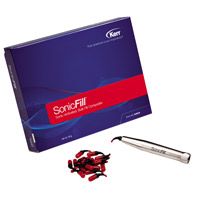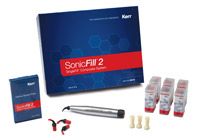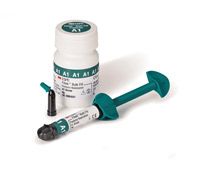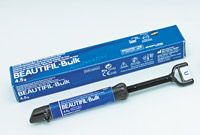Category Cruncher: Predictable Posterior Composites
Practitioners have been placing composite resin restorations for more than 60 years, and during this time, practitioners have gone from a world where only anterior teeth were restored with composite resin to a world where composite resin is used to restore essentially any tooth in the oral cavity.
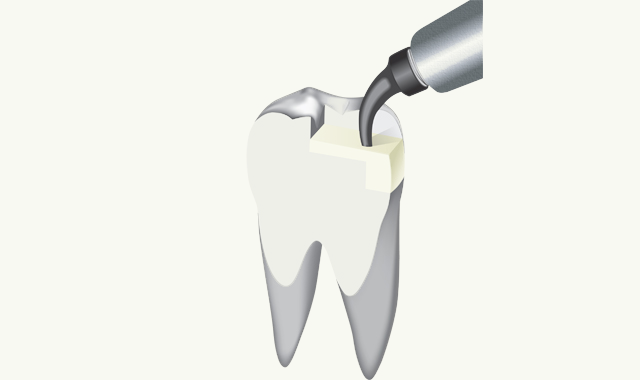
Practitioners have been placing composite resin restorations for more than 60 years, and during this time, practitioners have gone from a world where only anterior teeth were restored with composite resin to a world where composite resin is used to restore essentially any tooth in the oral cavity.
Over this time, the physical properties of the material have improved a great deal; however, the improved physical properties alone do not equate to successful restorations. This is particularly true in the posterior aspect of the mouth where many practitioners have struggled to predictably achieve composite restorations that have proper form and function and do not cause postoperative sensitivity. The placement of a successful composite restoration is multi-factorial and must take into account proper adhesion, material placement and polymerization. No single area can be ignored if the goal is to achieve long-term success.
Adhesion
The world of adhesion has evolved greatly since the time that Buoncore introduced acid etching enamel in 1955. During the late 1970s, enamel etching became fairly predictable as most fourth-generation adhesive systems recommended a 32- to 40-percent phosphoric acid etch for 15 seconds. During this time, the phosphoric acid dissolves away hydroxyapatite crystals from enamel, creating a roughened enamel surface for resin to penetrate. The relative homogeneity found in enamel allows for fairly predictable enamel adhesion to occur.
Dentin, on the other hand, is composed of collagen, hydroxyapatite and water, and the concentration of each of these changes depends on proximity to the pulp. During the late 1980s, dentin bonding started to gain popularity, and, as clinicians placed phosphoric acid etchant onto the dentition, the goal was to gain exposure to the collagen network and mechanically lock resin into this network to achieve high bond strengths. Unlike enamel bonding, dentin bonding proved to be much more complicated because of heterogenous structure. Dentin bonding at this time became achievable; however, true success was based on methodical technique.
Fourth-generation adhesive protocol consisted of three independent chemical components steps. The first step was to etch the dentin and enamel, followed by a rinsing and drying step. The next was to place a primer that would be soaked up by the collagen, and the third step was to apply the adhesive. To this day, fourth-generation adhesives, such as Optibond FL by Kerr, are still considered to be the gold standard and have shown tremendous long-term success, with studies showing a 94-percent retention rate at 13 years.
This generation of adhesives perform very well; however, they tend to be technique-sensitive and have a high film thickness, which can be challenging when adhesively bonding indirect restorations. To minimize the number of steps in the adhesion process, fifth-generation adhesives then came to market. The clinician was still required to etch both dentin and enamel; however, the primer and adhesive were put into the same bottle to allow for a single application after the etchant was rinsed off. Products like Prime and Bond NT by DENTSPLY, Adper Single by 3M ESPE and Optibond Solo+ by Kerr have been the primary adhesive for many clinicians for the last 15 years.
Being that the primer and adhesive are combined into one step, the proper treatment of dentin after etching becomes critically important, and many clinicians have reported the patient can experience post-op dentin sensitivity issues. In many cases, this may be tied to the dentin being overly dried after etching and the collagen network collapsing. This can lead to lower bond strengths and exposed dental tubules.
To combat the issue of sensitivity, self-etch adhesives have entered the marketplace. Two-bottle self-etch systems are generally referred to as sixth-generation adhesives. In this generation, the etchant and primer are combined into one bottle and the adhesive is in a second bottle.
Throughout the last several years, clinicians and researchers have reported very good success in this area in terms of minimal dentin sensitivity and very high dentin bond strengths. The only negative aspect seen with some sixth-generation adhesives is a lower enamel bond strength as the acid and primers combination tends not to create as effective of an enamel etch pattern as that seen with phosphoric acid. To combat this issue, many practitioners have opted to etch the enamel only with phosphoric acid (selective-etch technique) prior to applying the sixth-generation primer and adhesive system. Two sixth-generation adhesives that have shown favorable results both in terms of dentin and enamel etching are Optibond XTR by Kerr and Clearfil SE by Kuraray.
The newest generation of adhesives are commonly referred to as universal adhesives. These combine all components into one bottle and can be used both in a total-etch and self-etch technique. Generally speaking, products like Scotchbond Universal by 3M ESPE, All-Bond Universal by BISCO and Futurabond U by VOCO America are showing favorable initial results; however, the body of long-term success is limited at this time.
Regardless of which adhesive technique is used by the practitioner, success must be achieved at this point to have a successful final composite restoration.
Composite resin
For many years, practitioners have been told that to achieve a successful composite restoration, the material must be placed in increments that are less than 2mm to achieve proper polymerization of the material, as well as to prevent polymerization shrinkage stresses that can be distributed to the cusps. Generally speaking, practitioners that have used an incremental layering technique have achieved success; however, incremental layering can be very time-consuming and technique-sensitive.
Most individuals would agree that if resin can be developed to allow for a bulk placement, posterior composite restorations could be placed more predictably and efficiently. To this end, over the last five years, numerous products have come to market to address these issues. Products like SureFil SDR flow by DENTSPLY Caulk and Xtra Base by VOCO allow the practitioner to place an initial base layer of resin 4-5 mm in depth. Once polymerized, the base layer is capped with a traditional layer of composite. This technique offers very good adaptation of the material because of the initial low viscosity layer that is placed followed by a more filled capping layer that can withstand the forces of mastication. The initial studies of these materials show favorable results.
Another category of products that have come to market is one in which a single increment of composite resin is placed in a 4-5 mm increment to fill a cavity preparation in entirety. The clear benefit of this technique is further conservation of time; however proper adaptation of a 4-5 mm increment of composite may be difficult to achieve. Products in this category include Tetric EvoCeram Bulk by Ivoclar, X-tra fil by VOCO, Beautifil Bulk by Shofu and many others.
The ideal bulk fill composite would be one that can adapt nicely to all the walls of a cavity floor yet have enough body to easily anatomically blend the restoration into the adjacent unprepared tooth surface and withstand occlusal forces. To this end, the SonicFill system by Kerr addresses each of these issues. The system essentially allows for sonic energy to be delivered to a highly filled composite via a handpiece. As this energy is applied, the viscosity of the material drops by more than 80 percent, allowing it to nicely adapt to all walls of the preparation. As energy is removed, the composite resin starts to regain its viscosity over ample working time.
During this time, the proprietary resin can easily be sculpted so that it can be properly contoured and anatomical harmony can be achieved. The material can be placed in a single increment of up to 5mm before it needs to be polymerized. After polymerization, a standard polishing regimen can commence. SonicFill 2 will be introduced by Kerr soon, and improvements have been made to the resin to allow for easier polishing.
Case #1
Patient presented with recurrent caries in the distal box form of tooth No. 13 and new approximal caries on the distal of tooth No. 12. After consultation with the patient, a decision was made to remove the existing restoration and caries and place direct restorations. After administering anesthesia, the teeth were isolated utilizing a rubber dam. After complete caries excavation, the teeth were restored one at a time in order to achieve proper anatomical proximal contact. The system used was a sectional matrix (V3 Matrix) and wedge (Wave-Wedge), and ring (V3 Universal Ring) from Triodent. The deepest portion of each preparation was then measured, and both were found to be inside of 5mm. This finding allows one increment of the SonicFill A3 composite to be placed. After utilizing a total etch protocol and fifth-generation adhesive (Optibond Solo+), a single increment of SonicFill composite was placed, sculpted and fully cured utilizing a DemiUltra LED curing light. To achieve thorough polymerization, the restoration was initially cured for 20 seconds from the occlusal surface as well as 20 seconds from both the buccal and lingual surfaces after removing the sectional matrices. After removing the rubber dam, minor contouring was completed utilizing a 16-fluted carbide composite finishing bur (ET Series [Brasseler USA]). The restoration was polished utilizing a three-step silicone-impregnated rubber point system (Jiffy Polishers [Ultradent Products]).
Case #2
Patient presented with recurrent caries in the mesial and distal box form of tooth No. 30, and the adjacent teeth presented with clinically acceptable restorations.
The patient was informed the new restoration would be fairly large in size and the patient should consider an indirect restoration to minimize the chance of cuspal flexure and fracture. Taking into account the risks, benefits and alternatives, the patient decided to have a direct restoration placed. After administering anesthesia, the teeth were isolated utilizing a rubber dam. Upon complete caries excavation, the prepared surfaces were matrixed to allow for a properly contoured restoration to be placed. The system used was the V3 Matrix, the Wave-Wedge wedge and the Palodent Plus ring by DENTSPLY.
The deepest portion of the preparation was then measured, and both were found to be inside of 5mm. This finding allows one increment of the SonicFill 2 composite to be placed. After utilizing a total-etch protocol and fifth-generation adhesive (Optibond Solo+), a single increment of SonicFill 2 composite was placed, sculpted and then fully cured utilizing a DemiUltra LED curing light.
To predictably achieve thorough polymerization, the restoration was initially cured for 20 seconds from the occlusal surface as well as 20 seconds from both the buccal and lingual surfaces after removing the sectional matrices. After removing the rubber dam, minor contouring was completed utilizing a 16-fluted carbide composite finishing bur (ET Series [Brasseler USA]). The restoration was polished utilizing a three-step silicone-impregnated rubber point system, Ultradent’s Jiffy Polishers.
Watch the video below to see pictures of Cases 1 and 2:
Polymerization
It is incredibly important to realize that to be considered a successful composite resin restoration, the material must be fully polymerized. All curing lights are not created equal, and just because a blue light is being emitted from the tip of a light does not mean the composite is being fully cured. The physical properties of light-cured composite resin can only be achieved when the composite receives the right amount of energy at a specific wavelength.
In addition, enough of this energy should be delivered to the composite resin restoration without causing a significant temperature change to the pulpal tissue. Successful polymerization requires proper equipment and training. In a recent study by the ADA that looked at eight LED curing lights currently in the marketplace, only three lights showed the ability to have depth-of-cure measurements that were equivalent to or better then a standard halogen curing light. These lights were the DemiUltra by Kerr, Elipar S10 by 3M ESPE and the VALO by Ultradent.
In terms of operator technique, it is critically important that the team member who is responsible for curing is properly trained and that the patient is put into an ideal position so the tip of the light can get as close to the restoration as possible. The effective energy of all lights drops off as the light source moves away from the surface to be cured, and just because a restoration has a top surface that is hard does not mean the restoration is fully polymerized. Clinically, this can be a big issue in Class II restorations with a deep gingival box form.
It is very common for a light to float 3-4 mm off a tooth surface when it is activated, and this can mean a gingival box form is now 8-9 mm away from where the light is being emitted and gingival failure can become more likely. In terms of bulk fill resins, they tend to be slightly more translucent than traditional composites, and this is one of the primary reasons they can be cured in bulk. Based on the author’s experience, it is advisable to cure all resin-based restorations from the buccal and lingual surfaces in addition to the occlusal surface to maximize polymerization possibilities. Team members should also make sure curing tips are not damaged or covered with dental material that could inhibit proper curing. In addition, batteries and charging bases should be maintained to allow for optimal performance. One interesting point about Kerr’s DemiUltra is that it actually does not contain a battery at all. The light operates based on an ultra capacitor technology that allows it to fully charge in just 40 seconds. In addition, the light output is modulated every second through a process called periodic level shifting that allows the optimization of power while minimizing heat that may get to the pulpal tissue.
Summary
Posterior composite restorations are one of the most prevalent procedures that occur in dental practices today. When a practitioner blends proper technique with the advancements in technologies and material, these procedures can also become some of the most predictable. Efficiently placing natural-looking direct restorations that do not produce any post-operative sensitivity is very feasible today and should be considered the norm versus the exception.
SonicFill
Kerr SonicFill is a unique bulk fill system comprised of a specially designed handpiece and new composite material in Unidose tips. SonicFill’s composite incorporates a highly filled proprietary resin designed with special modifiers that react to sonic energy. As sonic energy is applied through the handpiece, the modifier causes the viscosity to drop (up to 87 percent), increasing the flowability of the composite and enabling quick placement and precise adaptation to the cavity walls. When the sonic energy is stopped, the composite returns to a more viscous, non-slumping state that is said to be perfect for carving and contouring.
Kerr
800-KERR-123 | kerrdental.com
SonicFill™ 2
Building upon the award-winning performance of its predecessor, SonicFill 2 is designed to transform tedious, repetitive posterior restorations into easy and reliable SingleFill placement, filling cavities up to 5mm in depth in a single increment with a single material and no liner or capping layer. The upgraded composite of SonicFill 2 was engineered using a new proprietary resin-infused zirkonsil filler system. Composed of nano-scale zirconium oxide and silica oxide particles, the improved composite reportedly imparts excellent gloss, wear resistance and strength to make bulk filling even easier and more reliable. SonicFill 2 is said to dramatically lower the viscosity of the composite during placement to ensure intimate adaption with the cavity surface. With its low shrinkage stress, high depth of cure and excellent mechanical and esthetic properties, SonicFill 2 is designed to meet the key requirements of a successful bulk fill procedure as you’ve come to expect from this market-leading product.
Kerr
800-KERR-123 | kerrdental.com
3M™ ESPE™ Filtek™ Bulk Fill Posterior Restorative
3M™ ESPE™ Filtek™ Bulk Fill Posterior Restorative reportedly gives dentists the ability to place up to 5 mm in one increment while offering excellent wear resistance and stress relief. By eliminating additional layers and multiple steps, Filtek Bulk Fill posterior restorative is designed to outshine competitors to give dentists a fast and easy option for direct posterior restorations. With this “one-and-done” option, dentists reportedly can save valuable chairtime and improve productivity. Designed for durability, Filtek Bulk Fill posterior restorative utilizes the same true nanofiller technology of other Filtek restoratives, which is said to enable high strength, wear resistance, surface smoothness and gloss retention.
3M ESPE
800-634-2249 | 3MESPE.com

Renamel Microhybrid
With more than 20 years of clinical excellence, Renamel Microhybrid reportedly is strong and opaque just like dentin. Because of its wetting properties, Renamel Microhybrid is said to be easy to place and manipulate in thin layers. The product offers SuperBrite shades for bleached teeth and includes shades A1, A2, A3, A3.5, A4, B1, B2, B3, B4, C1, C2, C3, C4, D2, D3, D4, CO, LI, MI, MWO, W, SB1, SB2 and SB3. Renamel Microhybrid is said to adapt well to underlying tooth structure and block unwanted undercolor.
Cosmedent
800-621-6729 | cosmedent.com
“I’ve been using Renamel Microhybrid since 1994 in cases large and small. Its ability to adapt to underlying tooth or composite layer is the best I’ve experienced. The chance of trapping air bubbles or having an open margin is reduced because of its viscosity.”
– Corky Willhite, DDS, FAACD

TPH Spectra®
TPH Spectra® Universal Composite is designed to provide the handling preference of choice with TPH Spectra LV (low viscosity) and TPH Spectra HV (high viscosity) that is spreadable or packable. The new shading system for the composite offers seven VITA-based shades that cover the entire VITA shade system. This reduction in shades allows for carrying fewer inventories in the office and is said to provide confidence that the chameleon shading ability of the composite will blend it in to the surrounding tooth structure making the restoration indistinguishable.
DENTSPLY Caulk
800-532-2855 | tphspectra.com
“TPH Spectra has taken all the attributes most practitioners would like in a direct composite resin - good handling, shade simplification, solid physical properties and ease of finish and polish and combined them into one product. It might be DENTSPLY Caulk's best composite ever!”
- Dr. Doug Lambert
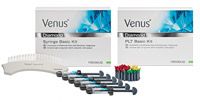
Venus Diamond
Venus Diamond is designed to embody a true balance of science and esthetics based on a patented cross-linked polymer matrix. With more than five years of extensive composite research that produced a patented chemistry, Venus Diamond is said to be the ideal choice for both anterior and posterior restorations. Offering a firmer, more packable consistency, Venus Diamond reportedly leads the industry in color adaptability with a patented formula that is designed to provide an outstanding natural look-replicating nature and mimicking tooth anatomy. Just one shade is said to save time and produces radiant results. The optimal physical properties of Venus Diamond reportedly offer a composite that truly performs in every category with low shrinkage stress, unique handling, exceptional strength and durability and perfect color adaptation.
Heraeus Kulzer
914-219-9000 | heraeus-kulzer-us.com
“An essential quality of a composite is the ability to create invisible margins by blending with natural tooth structure. Venus Diamond’s color adaptive matrix, combined with easy handling and polishing to a high luster, allows us to restore teeth to their natural beauty in both anterior and posterior restorations.”
- Howard S. Glazer, D.D.S., F.A.G.D.
Clearfil Majesty
Clearfil Majesty posterior composite is a light-cure, radiopaque restorative composite resin composed of nano-and micro-inorganic filler that is treated with a proprietary surface coating technology. The surface technology is designed to permit larger quantity of nanofiller to be dispersed in the resin matrix, which consists of monomer and microfiller. The resulting resin matrix is reinforced with a filler loading of 92-percent weight (82-percent volume). The product reportedly has an improved surface hardness that is close to that of human enamel, high mechanical strength, durability, high light curing depth and low polymerization shrinkage.
Kuraray America, Inc.
800-423-9762 | kuraray.us.com
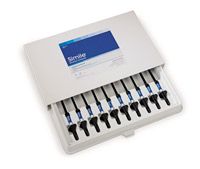
Simile™ Universal Composite
Simile™ Universal Composite is designed to combine strength and esthetics for both anterior and posterior restorations. With its outstanding physical properties and nano-hybrid formula, Simile is said to have been independently proven to deliver outstanding surface smoothness for an easy polish, superior polish retention and exceptional wear resistance. The reportedly extraordinary shine is visible as soon as you handle the material, and the low wear rates are said to result in a beautiful, long-lasting restoration. The soft, sculptable handling of Simile is designed to ensure the material won’t stick to the instrument at placement. Simile is offered in a convenient 10-shade introductory kit and has a total of 20 VITA shades, available in your choice of single dose or syringe.
Pentron
855-748-2964 | pentron.com
“We have been restoring anterior and posterior teeth using your Flow-it and Simile composite materials for more than seven years. Simile has proven to be a strong and durable product and is our composite of choice. It is not sticky and adapts well to the teeth. It is easy to apply and is highly polishable, making it ideal for anterior restorations as well as offering the strength needed for posterior Class II restorations. The shade choices match perfectly with our patient’s teeth. We are very pleased with this product. In combination with the excellent service we receive from Pentron, it is the composite of choice for our office.”
- Renee Walcom, RA
Beautifil Bulk Restorative
Beautifil Bulk Restorative is a conventional packable composite resin designed to incorporate the unique, bioactive benefits of Giomer, a surface prereacted glass filler that is backed by 13 years of clinical success. Beautifil Bulk Restorative has optimum translucency and a high fill ratio, which is said to reduce polymerization shrinkage stress while increasing compressive and flexural strength. With the balance of light diffusion and transmission that ensures complete polymerization at 4mm depth of cure, Beautifil Bulk Restorative has sustained fluoride release and rechargability, which makes it ideal for high caries patients. Indicated for direct posterior restorations, including occlusal surfaces, it is said to have excellent condensability and sculptability with minimized shade difference before and after light curing.
Shofu
800-827-4638 | shofu.com
“The material is highly esthetic because of the S-PRG filler. This filler allows for an ideal balance of light diffusion to penetrate deeply into the composite, while simultaneously creating an optimal opacity that matches and mimics the surrounding tooth structure quite nicely.”
– Dr. John Comisi, DDS, MAGD
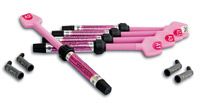
Estelite® Sigma Quick
Estelite® Sigma Quick is a supra-nano, 100-percent spherically filled universal composite that is designed to deliver a high-gloss, outstanding polishability and lasting shine on restorations. Its spherical fillers reportedly resist plucking for excellent wear resistance, while a quick curing time is said to allow for minimal volumetric shrinkage at 1.3 percent. Estelite® Sigma Quick has a creamy consistency and packs well into a variety of spaces, which is said to make it exceptionally versatile and easy to handle. It comes in a total of 20 shades, including variations of opaque and bleach shades. Its superior shade integration-combining up to 10 shades in a “chameleon effect”-reportedly reduces inventory costs without sacrificing esthetics.
Tokuyama Dental America
877-378-3548 | tokuyama-us.com
“Definitely a great handling material for both anterior and posterior restorations. Great opalescence and translucency allow it to blend very well with surrounding tooth.”
- Consultants from the Dental Advisor
x-tra fil
x-tra fil is an 86-percent filled (by weight) multi-hybrid, universal shade, bulk-fill composite that was developed to offer speed without sacrificing performance quality for posterior restorations. x-tra fil’s ability to cure 4mm layers in 10 seconds reportedly offers practitioners a real solution, especially when combined with Futurabond U or DC as the bonding adhesive. x-tra fil’s high performance quality is based on both its elevated physical characteristics, such as its 1.7-percent shrinkage (by volume), no-stick handling and high radiopacity (330-percent Al) as well as its dentin-like compressive strength, mechanical durability and thermal expansion.
VOCO America
888-658-2584 | vocoamerica.com
"xtrafil allows up to 4mm of material to be placed with only a 10-second cure-a time-saving benefit for many clinicians. Compared to traditional layering techniques, xtrafil offers a more forgiving technique for some clinicians. Esthetically, the blending capabilities of xtrafil's universal shade performs well in most posterior situations requiring less inventory by the clinician."
- Todd C. Snyder, DDS, AAACD, accredited Member - American Academy of Cosmetic Dentistry
